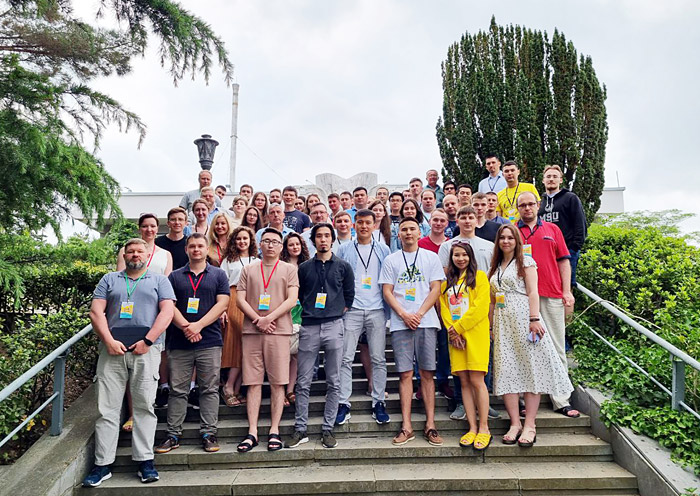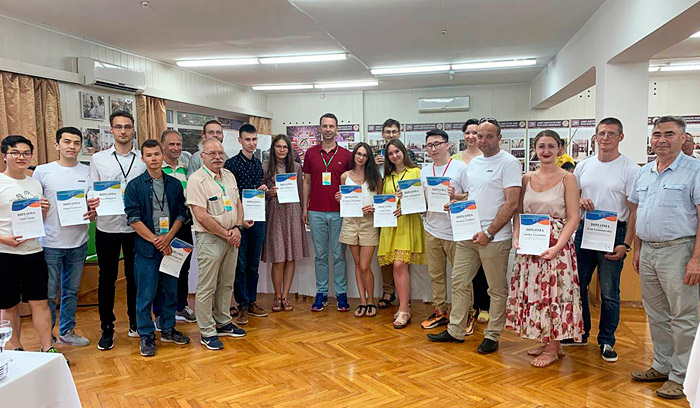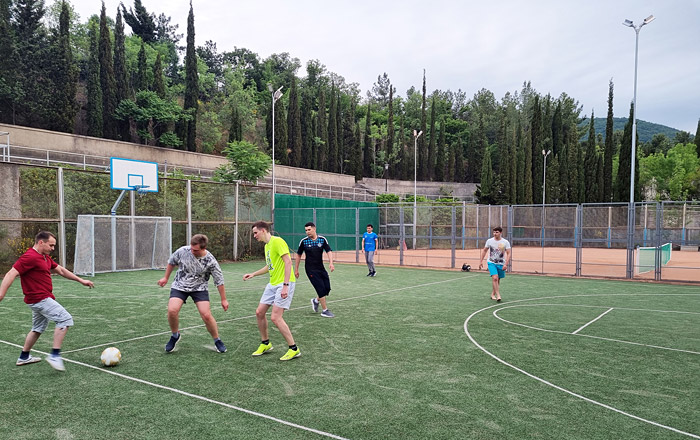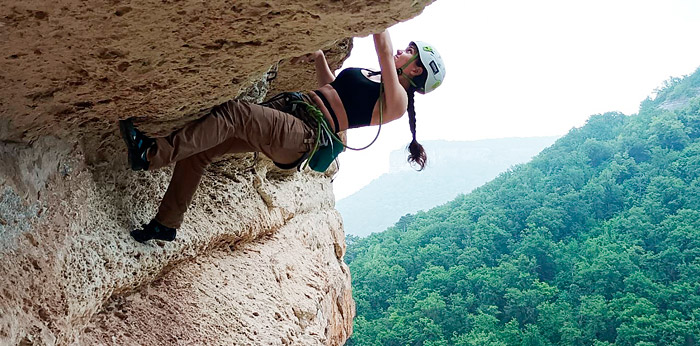
Electronic english version since 2022 |
The newspaper was founded in November 1957
| |
|
Number 23 (4620) |
Youth and science
Alushta-2022: the organiser's diary
When starting a report for a newspaper, I felt tempted to use the last year's publication, but with different pictures, to add +1 to the numbers and that's it. Alushta? Alushta! Conference? Conference! Did preparations start in March? Since March! It would seem that everything is as always ... However, this is only at first glance. First, transfer! Secondly, this year we decided to establish a new tradition - to involve not only young scientists and specialists, but also administrators in presentations. Thirdly, not only JINR employees took part in the work of the conference. The participants jokingly noted that the rains in the first few days of the conference were also an innovation of the organisers, setting them up for work. In addition, a cultural program was organised. What are you talking about? More? Okay, so then...
Day 0
"Please, don't forget the buttonhole! Immediately set up the camera, as soon as you arrive. Who has got merch? Has everything fit?.. "
These questions were asked not for the first time, the equipment was in place, everything required was prepared, the actions in case something went wrong were agreed, everything else was taken care of. Some of the organisers traditionally left a day earlier to test the equipment, to set up a video link with Dubna so that they could follow all lectures and reports and ask questions from JINR and also prepare for the registration of participants and the opening ceremony of the conference. It was also necessary to solve some of the issues related to the kitchen, so that the participants after a long journey could immediately refresh themselves and begin resettlement.

Day 1
For objective reasons, the conference participants traveled from Moscow to Simferopol by train. A two-story, comfortable express train rushed from our vast capital to the capital of the Crimean Republic in just 27 hours. To tell you a secret, among the feedback from the participants there were proposals to make the train transfer an annual event, despite the lack of air conditioning and the long journey. Socialization began on the platform. The guys helped the girls with their luggage, found out who was in which car, got to know each other, shared their first impressions. Then departure, the sound of wheels, a couple of small stops, arrival and gathering at the clock tower in Simferopol. Transfer to Alushta was very fast. It seemed that the steppe Crimea in the blink of an eye was replaced by a mountainous, rocky one. And then the sea shone in the distance. A couple of more moments and we are there - the familiar faces of the Institute's employees, the organisers meet the participants, help with unloading and advise where to leave things so that we can have lunch without wasting a minute, and then go through registration and check in.
At 7.00 PM the conference hall was waiting for all the participants at the opening ceremony. This year the conference was attended by more than 50 participants from 5 countries: Azerbaijan, Vietnam, Moldova, Russia, Romania. In addition to the JINR staff, young specialists from PJSC Tenzor came to Alushta this year. We hope that the tradition of attracting employees from third-party organisations will be maintained in the coming years, because such communication at least allows you to establish "horizontal relations" among the youth of urban enterprises. In addition to the traditional review lectures on current research in laboratories, there were also several lectures and plenary reports from the Institute's Directorate for young scientists and specialists.

Day 2
The first lecture started at 9:30 AM. In three hours, the first reports of the participants will start. Today employees from LRB and DLNP will perform. Some of the DLNP reports were dedicated to applied research and some others - to neutrino physics and the Baikal-GWD experiment. Questions from the audience made it clear that the topics raised were interesting and the speakers would not be let go so easily. The LRB reports were dedicated to the analysis of biological effects occurring from the combined effect of radiation and substances that increase the radiosensitivity of normal and tumor cells.
That's almost all for today. The first day is hard. Nobody has had a rest from the road and after dinner the participants will again have a lecture. Therefore, many decide to go to the sea. But the water temperature of 18 degrees and the clouds gathering in the sky made it clear that at this moment it is better to admire the sea from afar. But no matter, there are still four days of hard work at the conference ahead.
Day 3
Speakers from FLNP shared new results of using non-destructive methods of analysis of the substance, in particular, neutron radiography and tomography for the study of cultural heritage sites. Among the reports an experimental facility for elemental analysis using prompt gamma quanta at the research reactor IBR-2 was presented. After dinner, there was an interesting report by Leading Specialist of the Digital Services Development Department A.K.Samoshkov who spoke about the scheduling of scientific projects. The lecture aroused a lively discussion and keen interest among the participants. The day ended with the traditional QUIZ, where teams of young scientists and specialists were able to demonstrate their erudition and logic by answering interesting questions prepared by the organisers.
Day 4
One of the busiest days ever. In addition to a few lectures, the employees from FLNR made presentations about the work on the synthesis of superheavy elements, as well as about the preparation of new technological facilities at the Laboratory of Nuclear Reactions. The employees of the instrument factory "Tenzor" presented an extensive report on advanced developments in fire prevention and extinguishing systems. In turn, the procurement procedure and also the system of benefits and incentives developed at the Institute were elucidated in the reports of representatives of JINR structural subdivisions. The program of the event included a lecture by Head of Social Infrastructure Management Office of JINR, Chairman of the Council of Deputies of Dubna A.V.Tamonov, after which a discussion on the development of the science city was made: social infrastructure, clubs and associations, urban economy. A rather difficult and full of performances day was brightened up by a cool evening, when after a barbecue the participants played football, volleyball or table tennis.

Day 5
The equator of the Alushta Conference is celebrated as a free day. Free from lectures and reports and dedicated to the sightseeing of the wonderful nature of the Crimean Peninsula. This year, the participants could visit Ai-Petri, the Vorontsov Palace and a beautiful arboretum next to the palace. Some of them had a kayak swim in Balaklava Bay. Among the youth there were also climbers who, having put heavy equipment on themselves, arranged an ascent to the nearest rocks.

Day 6
June 10 was dedicated to VBLHEP lectures and reports. Young employees of the laboratory presented their papers in a very wide range, covering almost all research areas. The results obtained at the operating experimental facilities at BNL and CERN, the work on the development of a new hydrogen target for the SRC experiment, modeling and development of software for the experimental program at the NICA accelerator complex were highlighted. The session ended with reports on accelerator technology and charged particle motion dynamics, as well as magnetic measurements of superconducting magnets produced at VBLHEP for the NICA project.
In addition, the youth of the Institute were able to discuss current projects and the seven-year plan for the development of JINR with JINR Director G.V.Trubnikov after his lecture.
Day 7
Despite the fact that it was the final day, the scientific component was still very rich. BLTP and LIT staff presented interesting lectures and reports on novel IT developments that in the near future will be able to make the work of the Institute staff more convenient and efficient, for example, on the JINRex web service for system planning of excursions, developed jointly with the UC of JINR. LIT staff also spoke about the features of processing data from advanced physical experiments and introduced them to the cloud service for scientific computing at MIVC, the JINR institutional repository, and molecular dynamics modeling of the lipodisc in Alzheimer's disease. BLTP staff gave lectures and reports on black holes, holography and strongly interacting quark-gluon plasma; decays with two neutrinos and their relation to rare semileptonic decays of B-mesons.
For a dialogue on the most pressing issues, a round table was organised with JINR Directorate and Administration of the city of Dubna. During discussions and answers to the questions of the participants, Director of the Institute G.V.Trubnikov paid great attention to the international agenda, expansion of cooperation, the work of basic facilities and innovative research. In two hours, 16 questions were asked, to which the participants received detailed answers. I would like to take this opportunity to remind you that those wishing to address JINR Directorate with questions or suggestions can send them to ayss@jinr.ru.
By the end of the conference, the organisers prepared a couple of small surprises for the participants. In addition to the traditional awarding of the participants for the best report, they were treated to a cultural program - a performance by Meir Erdauletov on the domra, as well as a reporting video from the photos of the participants for the period of the conference, prepared by Tatiana Zaikina.
Day 8
On 12 June, Alushta saw off not just young scientists and specialists, but already colleagues, friends and comrades. The cold sea, the warmth of friendly meetings and cheerful memories of a wonderful time were left behind. Dubna was waiting ahead, new investigations and discoveries that could be told to colleagues next year, at the XXII Alushta conference - among wonderful people, in a wonderful place where there is no place for religious prejudices and political strife, but there is only science that, as everyone knows, brings nations together.
Vladislav ROZHKOV,
AYSS Chairman